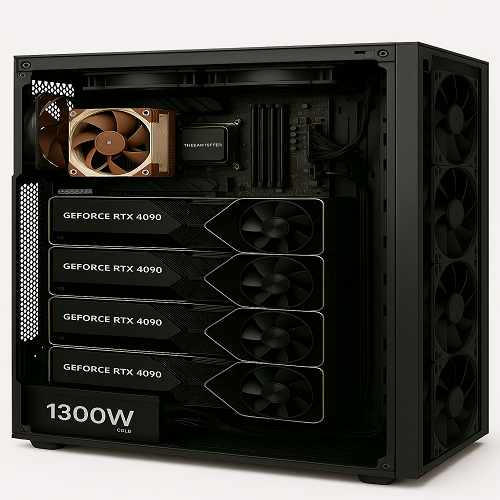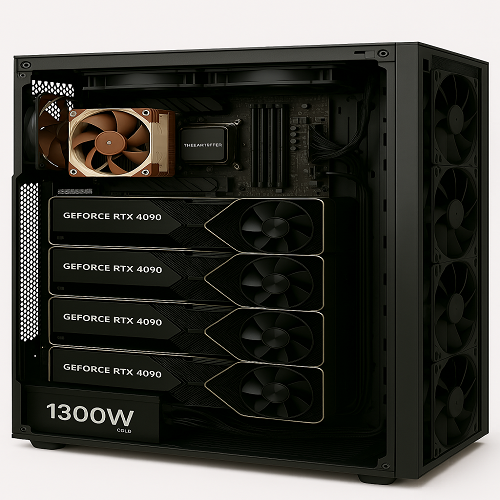sLLM or RAG AI Server 4X Nvidia Geforce RTX4090 Server
sLLM or RAG AI Server 4X Nvidia Geforce RTX4090 Server
AI Inference Server Specification: 4x NVIDIA GeForce RTX 4090
This configuration is designed for high-performance AI inference, capable of handling large language models (LLMs) that might exceed 24GB of VRAM per card by distributing them across multiple GPUs, or for significantly increasing throughput on smaller models.
1. Graphics Cards (GPUs)
-
4x NVIDIA GeForce RTX 4090 24GB GDDR6X
-
Reasoning: These are the core workhorses. With 24GB of VRAM each, four cards provide a massive 96GB of total VRAM for parallel inference tasks. Their high CUDA core count, Tensor Cores, and impressive memory bandwidth (1008 GB/s per card) make them exceptionally effective for AI inference.
-
Key Consideration: The physical size and cooling requirements of four RTX 4090s are substantial. You'll need a large case with excellent airflow and a motherboard with appropriate PCIe slot spacing.
-
2. Processor (CPU)
-
AMD Ryzen Threadripper 7000 Series (e.g., 7960X, 7970X) or Intel Core i9-14900K / 13900K / Intel Xeon E-2400/W-2400 Series
-
Reasoning: While inference is GPU-bound, a powerful CPU is crucial for managing data loading, preprocessing, post-processing, and orchestrating the four GPUs.
-
Threadripper (HEDT/Workstation): Offers a high number of PCIe lanes (PCIe 5.0) which is ideal for supporting four GPUs at high bandwidth (e.g., x16/x16/x16/x16 or x16/x16/x8/x8). It also provides a high core count for general system tasks.
-
Intel Core i9 (High-End Consumer): The 13900K/14900K offers excellent single-core and multi-core performance but typically has fewer PCIe lanes, potentially limiting all four GPUs to x8 or even x4 electrically. This might be acceptable for some inference workloads but could be a bottleneck for very high throughput or large model loading.
-
Intel Xeon (Workstation/Entry Server): E-2400 or W-2400 series offers more PCIe lanes and stability often associated with server platforms, making them good candidates if the budget allows for a more "server-like" foundation.
-
-
Recommendation: For optimal performance and expandability with four GPUs, an AMD Threadripper platform is highly recommended due to its superior PCIe lane count.
-
3. Motherboard
-
AMD TRX50 (for Threadripper) or High-End Intel Z790/W790 (for Core i9/Xeon)
-
Key Features:
-
4x PCIe 4.0/5.0 x16 physical slots: Crucially, these should provide sufficient electrical lanes (ideally x16/x16/x8/x8 or better) to avoid bottlenecking the GPUs. Threadripper platforms excel here.
-
Support for high-capacity DDR5 RAM.
-
Multiple M.2 NVMe slots (PCIe 4.0/5.0).
-
Robust VRM and power delivery: To handle the power demands of the CPU and four GPUs.
-
Excellent PCIe slot spacing: This is critical for physical fitment and proper airflow between the GPUs. Some boards are specifically designed for multi-GPU setups.
-
-
4. System Memory (RAM)
-
128GB (4x 32GB) or 256GB (8x 32GB) DDR5-6000MHz+ CL30 (or similar low-latency kit)
-
Reasoning: While GPUs hold the model weights, system RAM is essential for loading large datasets, intermediate activations, and running the operating system and frameworks. With four GPUs, you'll likely be dealing with larger inference jobs, making more system RAM beneficial.
-
Recommendation: Start with 128GB as a solid baseline. If you frequently handle very large datasets or run multiple inference jobs concurrently, 256GB would be ideal.
-
5. Storage
-
Primary: 2TB NVMe PCIe Gen4 SSD (or Gen5 if supported by motherboard)
-
Reasoning: For the OS, AI frameworks (PyTorch, TensorFlow), and frequently used large models. Faster loading times are crucial for large models.
-
-
Secondary: 4TB+ NVMe PCIe Gen4 SSD or SATA SSD (for model repository)
-
Reasoning: To store a wide variety of models and datasets. Given the size of many LLMs, a large, fast secondary storage is highly recommended. NVMe is preferred for speed, but SATA SSDs can be a cost-effective option for bulk storage.
-
6. Power Supply Unit (PSU)
-
1600W - 2000W 80 PLUS Platinum/Titanium Certified (ATX 3.0 & PCIe 5.0 ready with 12VHPWR connectors)
-
Reasoning: This is non-negotiable for a 4x RTX 4090 setup. Each RTX 4090 can consume up to 450W, totaling 1800W for just the GPUs under full load. You need significant headroom for the CPU, RAM, and other components. A high-efficiency (Platinum/Titanium) rating ensures stable power delivery and reduces waste heat. Ensure the PSU has at least four dedicated 12VHPWR (16-pin) connectors to avoid relying on multiple adapters.
-
Brand Recommendation: Reputable brands like Seasonic, Corsair, be quiet!, Silverstone, FSP.
-
7. Case
-
Full-Tower ATX Case with Exceptional Airflow, or a Server Chassis designed for multiple GPUs.
-
Key Features:
-
Massive Interior: Must accommodate four large, triple-slot (or wider) GPUs with enough space between them for proper airflow.
-
Excellent Cooling Mounts: Support for multiple large intake and exhaust fans (e.g., 3x 140mm front, 3x 140mm top, 1x 140mm rear).
-
Good Cable Management: Essential for maintaining airflow.
-
Sturdy Construction: To support the weight of the components.
-
-
Examples: Fractal Design Define 7 XL, Phanteks Enthoo Pro 2, Cooler Master HAF 700 EVO. Consider open-air test benches for initial setup and thermal testing if custom cooling is planned.
-
8. Cooling System (CPU & GPUs)
-
CPU: 360mm or 420mm AIO Liquid Cooler / High-End Air Cooler (e.g., Noctua NH-D15)
-
Reasoning: High-core-count CPUs generate significant heat. An AIO liquid cooler is generally recommended for consistent performance under heavy load, especially if you opt for a Threadripper.
-
-
Case Cooling: Multiple High-CFM Case Fans (e.g., Noctua NF-A12x25, Arctic P12/P14).
-
Reasoning: Proper airflow is critical to prevent thermal throttling of the GPUs. Hot air generated by the GPUs must be efficiently exhausted. Consider a positive pressure setup (more intake than exhaust) to manage dust.
-
-
GPU Cooling: While stock RTX 4090 coolers are powerful, in a 4-GPU setup, thermal management is the biggest challenge.
-
Consideration: If GPUs are directly adjacent, they can choke each other for air. Spacing on the motherboard is key. For extreme workloads, custom water cooling loops for all GPUs might be considered, but this significantly increases cost and complexity.
-
9. Operating System (OS)
-
Ubuntu 22.04 LTS (or newer LTS version)
-
Reasoning: The industry standard for AI and deep learning. It offers robust support for NVIDIA CUDA drivers, cuDNN, and all major AI frameworks (PyTorch, TensorFlow, etc.), ensuring optimal performance and compatibility.
-
Couldn't load pickup availability
Low stock: 1 left
View full details
